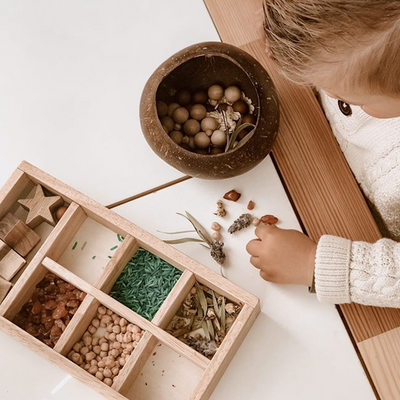Scoop, Squish, Pour: Sensory Play Ideas Kids Will Love
Jul 17, 2025
There’s something really sweet about the way little ones explore the world. They scoop up rice, squish soft dough, and pour water like it’s the most important job in the world. And while it might just look like a bit of messy fun, it’s actually helping them learn and grow. It builds their brains, sparks creativity, and boosts their confidence. This is the magic of sensory play. It all starts with a touch, a sound, a scent, and a whole lot of imagination.
What Is Sensory Play?
Sensory play involves any activity that stimulates a child’s senses: touch, smell, taste, sight, and hearing. It also includes movement and balance. These experiences are necessary for young children as their brains are constantly forming new connections, especially in the early years.
But sensory play isn’t just educational. It’s joyful. It invites children to follow their curiosity, test ideas, and engage with the world on their own terms. It nurtures wonder.
Why Sensory Play Matters
Here’s what’s really happening when your child digs into a sensory bin or stirs up “nature soup” in the backyard:
- Fine and gross motor skills develop through pouring, squeezing, pinching, and stirring.
- Language blossoms as children describe textures, temperatures, colours, and actions.
- Cognitive connections form as they explore cause and effect (for example, “What happens when I mix vinegar with baking soda?”).
- Emotional regulation improves, as sensory play helps calm big feelings and provides a safe space to unwind.
- Focus and persistence grow as children engage deeply in open-ended, hands-on experiences.
Most importantly, sensory play fosters independence and confidence. It says to a child: You are capable of discovering things on your own.
Five Sensory Play Ideas Kids Will Love
You don’t need fancy equipment to start. Just a few simple materials, some inspiration, and a willingness to get a little messy.
1. Rainbow Rice Treasure Hunt
- What You’ll Need: Coloured rice, small toys or letters, scoops and bowls (like our Qtoys Mini Wooden Bowls).
- How to Play: Hide treasures in a bin filled with rainbow rice and invite your child to dig, scoop, and discover.
- Why It Works: Supports fine motor skills and visual scanning, while offering calming, repetitive motions.
2. Frozen Rescue
- What You’ll Need: Small waterproof toys, ice cube trays, water, and droppers or warm water.
- How to Play: Freeze the toys in water overnight. Let your child melt the ice using droppers or spray bottles.
- Why It Works: Encourages problem-solving and hand-eye coordination. It’s also a cool sensory experience on a warm day.
3. Foamy Wash Station
- What You’ll Need: Dish soap, water, toy cars or dolls, and a small tub.
- How to Play: Create bubbly foam and invite your child to wash and rinse toy vehicles or dolls. Try it with the Djeco Dolls Bathtub.
- Why It Works: Combines pretend play with tactile water exploration, which is perfect for sensory seekers.
4. Nature Soup
- What You’ll Need: Leaves, petals, sticks, water, and old kitchen tools.
- How to Play: Head outdoors and let your child collect natural items. Stir them into a “soup” using spoons and ladles.
- Why It Works: Encourages outdoor exploration and sensory integration through smell, texture, and sound.
5. Fizzing Science Fun
- What You’ll Need: Bicarbonate of soda, vinegar, food colouring, droppers or spoons.
- How to Play: Set up trays with coloured bicarb. Drop vinegar on top and watch it fizz.
- Why It Works: Introduces basic science concepts and cause-and-effect while captivating the senses.
Creating a Sensory-Friendly Play Space
You don’t need a dedicated playroom to make sensory magic happen. Here are some simple tips to keep it fun and stress-free:
- Use trays, plastic bins, or shallow boxes to keep materials in one place.
- Have towels, aprons, or a washable mat on hand to manage clean-up.
- Store materials in labelled containers and rotate them every few weeks to spark renewed interest.
Let your child help choose or prepare the materials. Involving them makes the experience more meaningful.
Tailoring Sensory Play for Different Ages
Babies (0–6 months): At this stage, sensory play is all about gentle stimulation. Try soft fabrics, high-contrast toys, baby-safe mirrors, and gentle music. Let them explore textures with their hands and feet during tummy time with the Viga Grow with Me Educational Toy Box.
Babies (6–18 months): Stick to taste-safe materials like cooked pasta, edible finger paints, or frozen fruit cubes.
Toddlers (18 months–3 years): Simple activities such as water play, textured fabrics, and sandbox fun work best. Check out the Tenderleaf My Forest Floor Set pictured below.
Preschoolers (3–5 years): They’re ready for more complex setups like pretend cooking stations, colour mixing, or sensory storytelling.
Neurodiverse children: Sensory play can be especially soothing. Follow your child’s lead. Some may love messy play while others prefer dry or structured experiences.
When we take a moment to watch our kids stir, squish, pour, and play, we’re seeing something pretty amazing. It’s the joy of discovering the world around them. Sensory play reminds us that learning doesn’t have to come from worksheets or screens. It starts with curiosity, a bit of mess, and the freedom to explore.
Whether it’s a simple tub of water or some thoughtfully chosen wooden tools, it’s not just playtime. It’s hands-on learning that supports focus, problem-solving, and self-confidence. One little squish at a time, you’re laying the foundation for lifelong learning in the most natural way.
Looking to bring more sensory magic into your home or childcare centre?Explore our full collection of sensory-friendly, nature-based, and open-ended play resources here.


